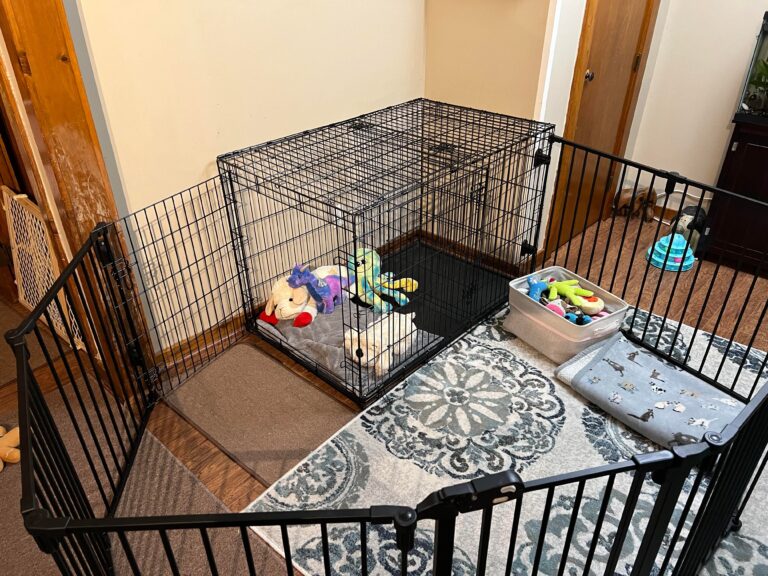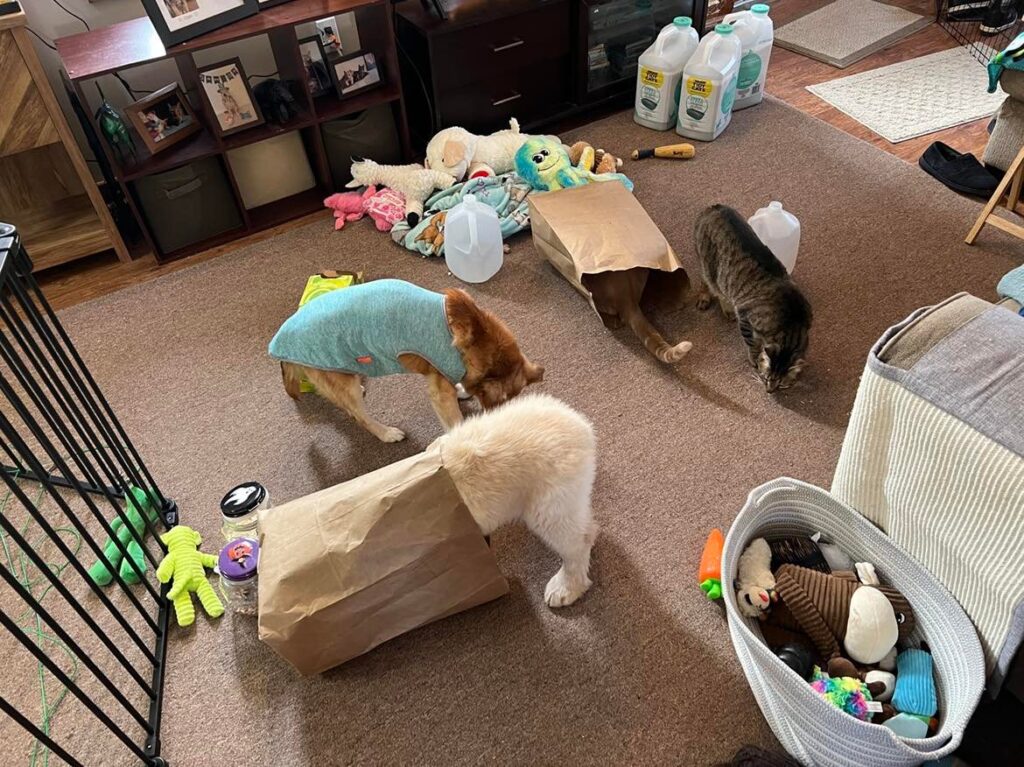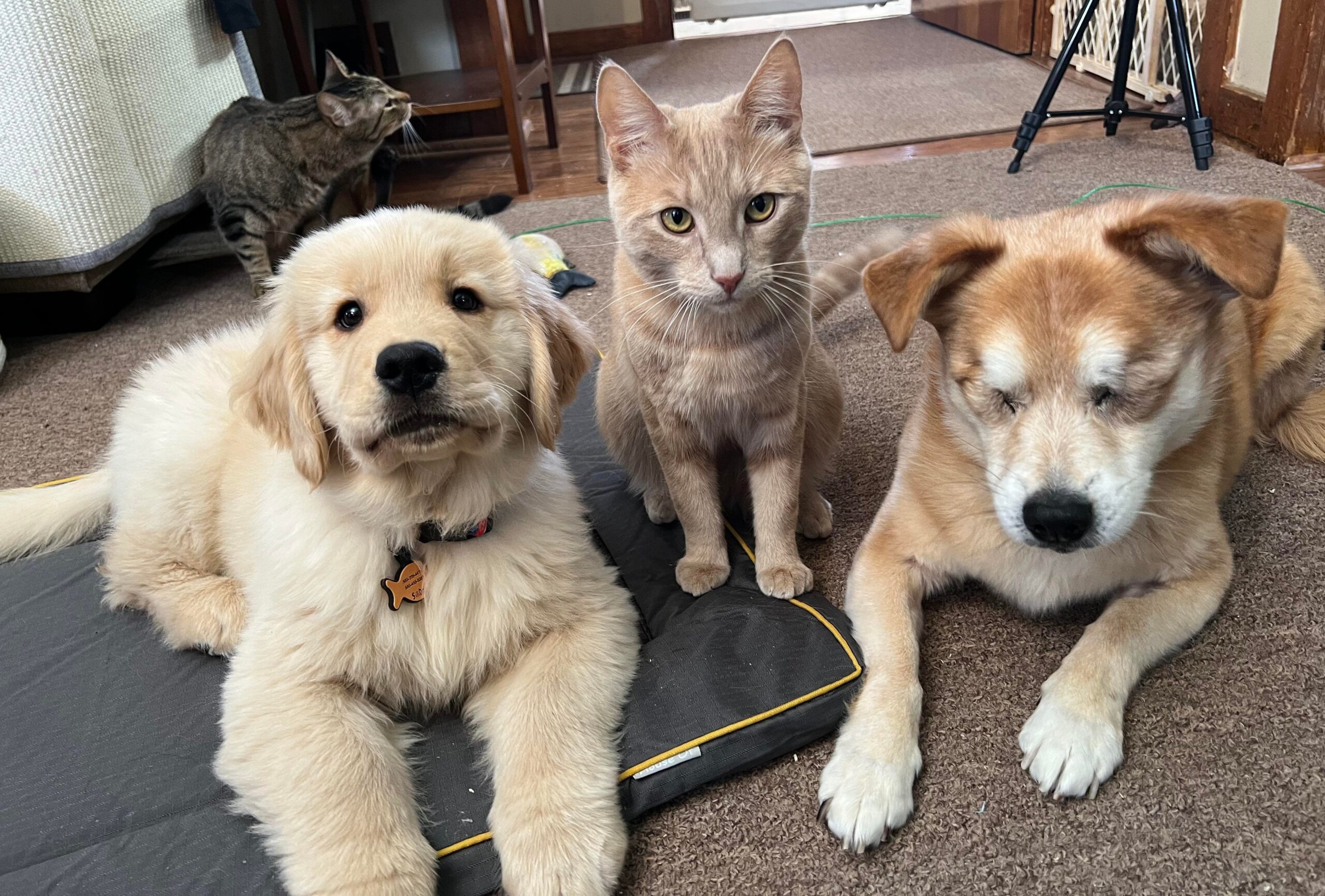The challenges of integrating a new puppy with 2 cats and a blind dog
This blog was originally published on 3/5/2023 and printed in the Summer 2022 edition of the APDT Chronicle of the Dog. Click here for a PDF.
I knew it would be challenging when I decided to bring a puppy into our home. Not just because of the typical puppy chewing, potty training, and crate training, but because my priority was, and still is, the comfort of our resident cats and dogs during the integration process. As a dog behavior consultant, I work with many owners that bring new dogs into their homes while hoping a bond will be instantly created with the resident pets.
What seems like play to some owners (chasing the cat who now only enters the room when the puppy is sleeping, chewing on the older dog who jumps onto the couch so the puppy cannot reach him) are actually stressful interactions. There are so many things you can do to keep your home a comfortable place for all your pets and keep them all safe. I’m going to describe the changes I made to help integrate my new puppy into the household. They started long before I got him.
Resident Pets
Before diving into the processes and training I have put in place, let me introduce you to the resident pets in my home. Si is a nine-year-old cat with stomach cancer. While he is thriving, I cannot overemphasize the importance of keeping his stress levels low, as stress can lead to vomiting flare-ups. Nimbus is an eight-month-old cat that arrived in our home four months ago. Jeter is a blind twelve-year-old terrier mix who is indifferent to other dogs. All three are nervous and require slow introductions and training with any new person or animal.
I made changes in our home before our eight-week-old Golden Retriever, Fisher, arrived. First, I set up a crate and attached an x-pen to the walls around it, giving Fisher room to explore while not being forced to stay in his crate if the other pets needed a break from him.
Second, I bought baby gates to block access to the upstairs, kitchen, and training room. The baby gates allowed our cats, Si and Nimbus, to jump over and retreat to an area where Fisher could not reach them. The upstairs is currently a designated safe space only for the other pets.
Third, I placed a crate in the living room and attached a sturdy x-pen to it. This was the foundation for separation training so that Fisher could understand it is okay to be away from us.
Finally, I attached a tether to the outside of the x-pen. This would be used as a “time out” area when Fisher needed a break for nipping

or other behaviors that I did not want to continue and were unable to be redirected at the time. The crate and x-pen are areas that I want Fisher to enjoy relaxing in and they are never to be used as a punishment.
Introductions
Training began the moment that Fisher walked into our home. This is because every interaction with your dog is a learning experience, even when they are not in a formal training session. I wanted to start out very clear in my expectations for Fisher: Nimbus, Si, and Jeter were not to be chased or pestered to play. That might sound harsh, but I would be providing Fisher with other dogs that did want to play with him so he could have an appropriate outlet for his natural behavior. Nimbus might want to play and cuddle with him in the future, but not right now.
Consistency was key. If I were to sometimes allow Fisher to chase the other pets and other times not, what I was trying to communicate to Fisher would become muddled. While I did not let Fisher chase them on purpose, it did happen a couple of times and the pets gave him appropriate corrections. It was still my job to teach him what to do instead. I began rewarding him for doing anything that I liked every time I saw him do it. I caught him being good. In the captioned video, you will see me demonstrating exactly what I mean.
I did not discipline Fisher for focusing on Nimbus or chewing on the couch. Instead, I directed him to a more appropriate activity. The other pets were offered chicken treats to help build a positive association with Fisher’s presence.
While unsure of Fisher, Nimbus is highly food motivated. As a result, when I was tossing treats to Fisher in the portable x-pen for relaxing, Nimbus jumped inside to grab some. The task of relaxing became exponentially more difficult for Fisher as a result, as the opportunity to chase Nimbus presented itself.
I immediately increased my rate of reinforcement by tossing treats more quickly to Fisher. Instead of a treat every few minutes, Fisher was getting a treat every few seconds.
(You will see that I am dropping treats into the pen from the top left corner of the screen.)
Building Behaviors
Managing the environment and catching Fisher being good were only two pieces of the behavior puzzle. I also needed to teach Fisher what I wanted him to do instead of pestering the other pets: relax on his bed and disengage from them.
I brought out Fisher’s training bed only when I knew I would be able to work with him. I started out by reinforcing Fisher with a treat for sitting, a behavior that he regularly offered. Then I placed the treats on the bed to encourage him to go into the down position and stay there. I practiced walking away and returning to Fisher with a treat before he got up to follow me. After multiple repetitions, I gave him the release cue and encouraged him to get up.
If Fisher walked back towards the bed to investigate, I put a treat on it. If he sat or lay on the bed, he would get a “jackpot” of multiple treats. By reinforcing these behaviors, I was teaching Fisher that he could get my attention, and he could get treats, simply by interacting with his bed. Once the strong foundation was built, I would then start reducing the rate of reinforcement.
Jeter, Nimbus, and Si were allowed access to the room when Fisher and I were training only when I was confident that he was able to handle the extra distractions. I then implemented an activity called “click the trigger.” Anytime Fisher looked at one of the other pets (a trigger) I would immediately mark him for looking by saying “yes” and placing a treat on the bed.
During non-formal training sessions as described above, Fisher was still learning so I was still catching him being good. If I was unable to actively supervise Fisher, I gave him a break in his crate or x-pen.
Interactions with other pets
Si, the more cautious of the other three pets, started to investigate Fisher during calm moments. First from above, which is where cats tend to observe and relax, then from ground level. The fact that Si was looking away while keeping an ear toward Fisher meant that we were on the right track to helping Si become comfortable.
Si joined Fisher and me during a training session and we took the opportunity to work on the pets taking turns. This activity began to teach Fisher that he can see the cat next to him, he can see the cat get treats, and he does not have to go for the cat or the treats. He can get reinforced just for remaining in place.
As the other pets became comfortable with Fisher, they began to initiate interactions and relax in his presence. Nimbus used the safety of the baby gate to invite Fisher to play, Jeter moved closer towards Fisher during some naps, and Si napped peacefully on the couch. If Fisher’s puppy behaviors became pushy or overwhelming, I removed Fisher from the situation and the other pet was given a treat. The treat was to help the pet create a good association with Fisher’s behavior: “When Fisher paws my back, I get a treat. It’s not so bad when Fisher paws me.”

Group activities
Fisher, Jeter, Nimbus, and Si were introduced to group activities when I was confident there would not be conflict between them.
I did not force any of the pets to participate and they could leave whenever they wanted to. We started with a structured activity where they took turns getting treats. The goals were to teach them not to be pushy and not to take food when it was being handed to another pet.
The less structured activity turned out to be their favorite. I had originally set up an enrichment area for Fisher to interact with novel items and build his problem-solving skills. The other three pets quickly joined in. I scattered treats in, under, and around paper bags, jugs, and boxes. None of the pets previously showed signs of guarding food or items so I welcomed the opportunity for everyone to participate and bond.
Fast forward 3 months
While Fisher has only been in our home for a short time but his relationship with Jeter, Si, and Nimbus continues to grow in the right direction. Not only have Jeter and Fisher have been caught relaxing on the dog bed together, but they played tug for the first time. This is a huge accomplishment seeing that I have never seen Jeter play with another dog.


